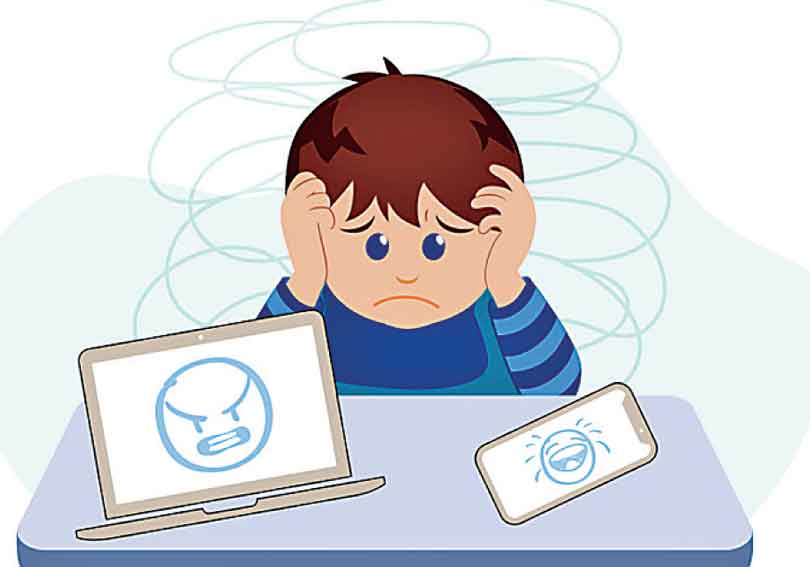Sunday Oct 26, 2025
Sunday Oct 26, 2025
Thursday, 2 October 2025 14:49 - - {{hitsCtrl.values.hits}}

The rise of digital technology has created new spaces for children to learn, connect and grow. From online classrooms to social media and gaming platforms, the digital world has become an integral part of childhood. However, with these opportunities comes a growing risk—online harassment and cyberbullying. On World Children’s Day, it is essential to spotlight the importance of protecting children in virtual environments and ensuring their voices, emotions and safety are not compromised.
Cyberbullying takes many forms, including threatening messages, mockery, impersonation, spreading rumours, posting embarrassing photos or excluding someone from online groups. Unlike physical bullying, digital abuse can happen anywhere, anytime—even from behind a screen—and often goes unnoticed by adults. A single harmful post can reach hundreds within seconds, leaving lasting emotional scars.
The psychological impact of cyberbullying on children is profound. Victims may experience anxiety, loneliness, fear, humiliation and depression. Their confidence can drop, affecting academic performance, friendships and family relationships. In severe cases, cyberbullying has led to self-harm, school refusal and long-term trauma. Because children often hesitate to speak up, many suffer in silence while trying to navigate complex emotions alone.
Parents have a crucial role in safeguarding their children. Creating a safe space for open conversations is the first step. Instead of reacting with blame or anger, parents should encourage children to discuss their online experiences freely. Setting age-appropriate screen time limits, monitoring privacy settings and staying informed about the apps children use can help prevent harmful situations. Parents should also watch for signs such as irritability, withdrawal, mood swings, sleep disturbances or sudden disinterest in digital devices or schoolwork.
Schools are equally responsible for prevention and intervention. Digital citizenship education should be part of the curriculum, teaching students about respect, empathy, privacy and the consequences of harmful online actions. Anti-bullying policies must include cyberbullying, with clear steps for reporting and addressing incidents. Teachers and counselors should be trained to identify victims and respond sensitively, ensuring that the child does not feel blamed or isolated. Student-led peer support groups and awareness campaigns can create safer school cultures and empower children to stand against digital bullying.
Community involvement adds another layer of protection. NGOs, youth organizations and child protection agencies can conduct workshops, helplines and outreach programmes. Public awareness campaigns through media and social platforms can educate parents, children and teachers about cyber safety, mental wellbeing and responsible online conduct.
Technology companies must also take accountability. Social media platforms, messaging apps and gaming networks should invest in stronger monitoring systems, AI moderation tools and quick-response mechanisms to report and remove abusive content. Child-friendly settings, privacy controls and age verification processes should be mandatory. Clear communication channels for complaints can help victims feel supported and heard.
Governments can support these efforts by strengthening legal frameworks that criminalize cyberbullying and protect children’s rights online. Collaboration between ministries of education, justice and telecommunications can result in practical guidelines and enforcement mechanisms. Hotlines, support services and data protection policies must be available at national and community levels.
Children themselves need awareness and confidence to protect their digital wellbeing. They should be encouraged to speak up if they feel threatened, harassed or uncomfortable online. Teaching them to block unsafe contacts, report abuse, avoid oversharing personal details and use secure privacy settings is essential. Empowering children to be upstanders—not silent bystanders—helps create safer online communities.
Emotional resilience also plays a key role. Children who feel supported, loved and understood are better equipped to handle challenges. Families can promote hobbies, outdoor activities and social interaction beyond screens to ensure children are not overly dependent on digital validation.
Protecting children from cyberbullying requires teamwork—parents, schools, communities, tech companies, policymakers and children themselves must work together. It is not enough to react after harm occurs; proactive measures, education and empathy are essential to prevention.
On this World Children’s Day, let us commit to building digital spaces rooted in kindness and safety. Every child deserves the freedom to learn, play and connect without fear of humiliation or harassment. By listening, guiding and acting together, we can ensure that technology becomes a tool for progress—not pain—in a child’s life.